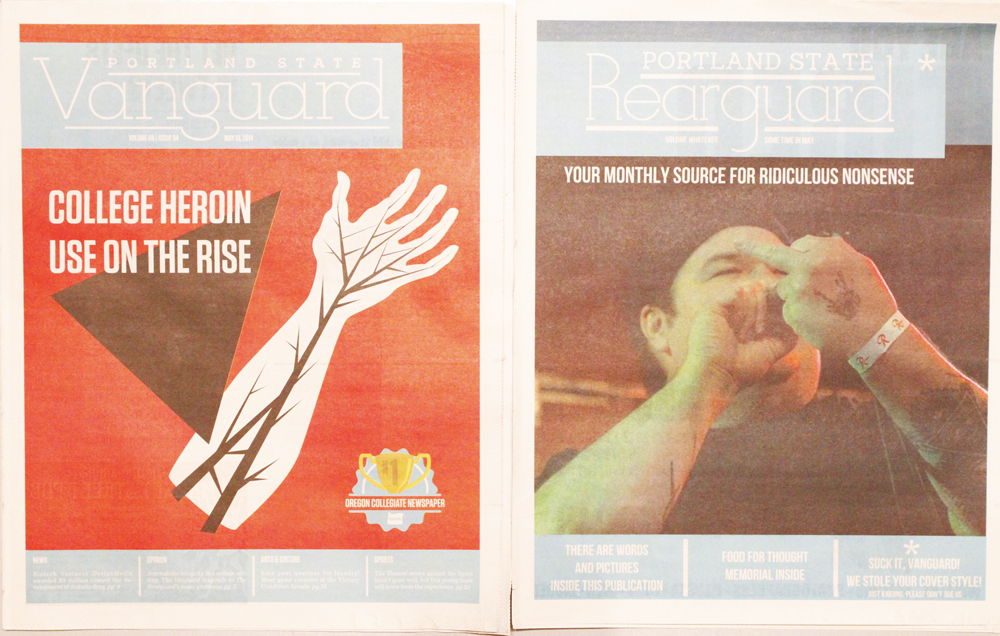In an evening of cultural celebration, the Portland State Pacific Islanders Club hosted their 12th annual Lu’au at the Peter Stott Center on May 10.
Doors opened at 4:30 p.m., admitting crowds into the lobby to browse the vendors’ tables lining the walls. Families lined up at Aunty Elsie’s Shaved Ice and Vita Coco for treats, while others bought jewelry, clothing and souvenirs at Kiss of Polynesia, Dakine Island Stuff, Bula Kava House, Kiana’s Hawaiian Jewelry and Ka Pa Hula Makani Kolonahe.
By the time the main doors opened at 5 p.m., the lobby was overflowing with guests. As attendees filtered into the main gym, which had transformed with a stage, tables and decorations, people took seats in the bleachers or at reserved tables next to the stage.
The 2014 Lu’au’s theme, “Languages of the Pacific,” was displayed by a set of colorful banners hung across the wall, each exhibiting the name of an island from which the languages used in the show originated, including Fiji, New Zealand, Tahiti, Hawaii, Tonga and Samoa.
“Our target for the evening was to learn more about each other’s cultures, while also teaching the Portland community about the Pacific Islands and hopefully building club numbers,” said Chante Hillen, co-cultural chair of the Pacific Islanders Club and PSU senior majoring in human resources and leadership management.
The menu for the evening, a traditional Hawaiian plate lunch from the local Kauai Island Grill, included rice, BBQ chicken, kalua pig, yakisoba (vegetarian noodles), lomi lomi salmon (tomato and salmon salad), haupia (a coconut milk-based pudding) and panipopo (sweet coconut buns).
While waiting for dinner, event attendees were entertained by a live band and had the chance to win prizes by answering trivia questions and participating in a raffle. Guests were also entertained by performances led by Pacific Islanders Clubs from Madison, Franklin and Roosevelt high schools. A photo booth was another popular activity.
“The band is actually made up of the family of members of the PIC,” said Darren Acoba, PIC president and junior at PSU studying public health education. “They’re also alumni of PSU, which is really cool. We’re lucky to have them.”
The main show kicked off with dances from Hawaii. As the main lights went down and the stage lights up, the men began with a dance called Hole Waimea. The dance told the story of Kipu’upu’u, a band of runners trained in spear fighting named for the cold wind of Mauna Kea.
Next up, the women performed the dance He ‘Ui in traditional Pacific Island dress. Trading back and forth, the men and women each performed traditional Hawaiian dances, E Hihiwai and He Aloha Nihoa.
As the dances left Hawaii to enter Samoa, the audience was taught about the island’s traditions, as well as the usual greeting in the Samoan language. The Samoan dances performed included Alamagoto, La’u Samoa/Ta Fia iloa, and Lome Lome.
As the dances left Samoa for Tahiti, the audience learned about Tahitian culture and the traditional Tahitian greeting. The Tahitian dances performed included Tomora’a, Hei No Tamatoa, and Pate Pate.
To show their solidity and support for each other, the PIC officers performed the last dance, Pate Pate, together. Audience members were also given the chance to come up on stage and learn a Tahitian dance.
Next, a fire knife dance was performed. Two dancers showed off their skills while twirling and dancing with a fiery branch in hand.
“The fire dances were amazing,” said Austin Rhodes, a sophomore at PSU studying business. “I was a little bit nervous for them, honestly, but they definitely knew what they were doing.”
As the dances came to an end audience members flocked to the dance floor and took pictures with the elaborately dressed performers.
“I hope that through this event we were able to enrich diversity at PSU and help people have fun while becoming familiar with the Pacific Island cultures,” said Acoba. “One of the biggest misconceptions about our club is that you have to be from the Pacific Islands to join. We welcome everyone. It’s fun to be able to learn about each other’s cultures.”





